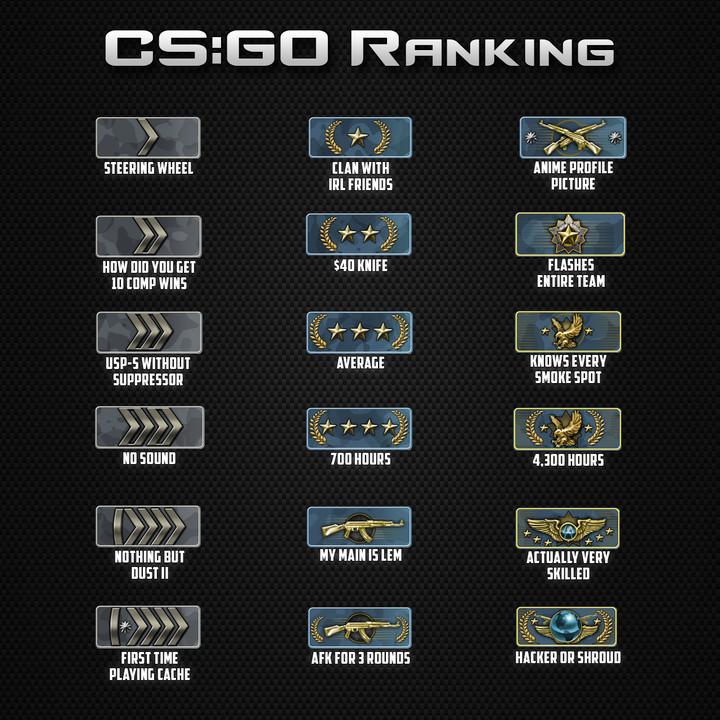Hookup Doc: Your Go-To Guide for All Things Dating
Explore the latest trends, tips, and advice in the world of dating and relationships.
A Rank by Any Other Name: CS:GO and Its Intriguing Hierarchy
Explore the fascinating hierarchy of CS:GO ranks and uncover what each level truly represents in the world of competitive gaming!
Understanding CS:GO's Ranking System: A Deep Dive into Competitive Hierarchy
The Counter-Strike: Global Offensive (CS:GO) ranking system is a crucial element that dictates the skill level of each player in the competitive mode. This ranking system consists of 18 different ranks, ranging from Silver I to Global Elite, with each rank representing a player's skill and ability in the game. To understand how players progress through these ranks, it's important to recognize the factors that influence ranking: win-loss ratios, individual performance, and match performance. Players earn or lose Elo points based on these criteria, which ultimately affects their overall rank. A deeper understanding of this system can not only help players improve their gameplay but also enhance their chances of advancing to higher ranks.
One of the key aspects of the CS:GO ranking system is the presence of matchmaking, which pairs players of similar skill levels to create balanced matches. This ensures that players face opponents who can challenge them adequately, fostering a competitive environment. Additionally, players are categorized into groups using an algorithm that considers their past performances and current win streaks. As a result, learning the intricacies of the ranking system can bolster a player's strategy and gameplay, enabling them to climb the ranks effectively. Whether you're new to the game or a seasoned player, grasping how this competitive hierarchy works can lead to an enriched gaming experience.

Counter-Strike is a highly popular first-person shooter game that focuses on team-based gameplay. Players select either the terrorist or counter-terrorist side and engage in various game modes. One of the coveted items players seek is the chroma 3 case, which can contain rare skins and weapons that enhance the gaming experience.
From Silver to Global Elite: Navigating the Ranks in CS:GO
In Counter-Strike: Global Offensive (CS:GO), the journey from Silver to Global Elite is both challenging and rewarding. Players often find themselves stuck in the Silver ranks due to a lack of understanding of game mechanics, strategies, or poor teamwork. To effectively navigate these ranks, it's essential to focus on several key areas: map knowledge, aim training, and effective communication. By mastering these fundamentals, players can begin to rise through the ranks and challenge themselves at higher levels of competition.
Once you have a solid grasp on the basics, the next step is to refine your skills and adapt your gameplay. This can involve analyzing your own replays to identify mistakes, seeking out guides and tutorials, or even collaborating with teammates to develop strategies that exploit your opponents' weaknesses. Engaging with the CS:GO community, whether through forums or social media, can provide additional insights and support as you strive to transition from the Silver rank to the coveted Global Elite status. Keep pushing yourself, stay persistent, and remember: improvement is a gradual process!
Why Does CS:GO's Ranking System Matter? Exploring Its Impact on Gameplay
The ranking system in CS:GO plays a critical role in shaping the overall gameplay experience. By assigning players a specific rank based on their performance, it fosters competition and encourages skill development. When players see their rank fluctuate, it motivates them to improve, which translates to heightened engagement and enjoyment of the game. Furthermore, this system helps create balanced matches by pairing players of similar skill levels, reducing instances of overwhelming victories or crushing defeats that can lead to frustration.
Moreover, understanding the impact of the ranking system on gameplay can also enhance strategic decision-making. Players often tailor their tactics based on their rank, as those in higher tiers typically exhibit greater teamwork and refined skills. This dynamic necessitates adaptability and continuous learning, which are essential for success in CS:GO. Therefore, the ranking system not only influences individual player progression but also shapes the overall competitive landscape, promoting a healthier and more challenging gaming environment.